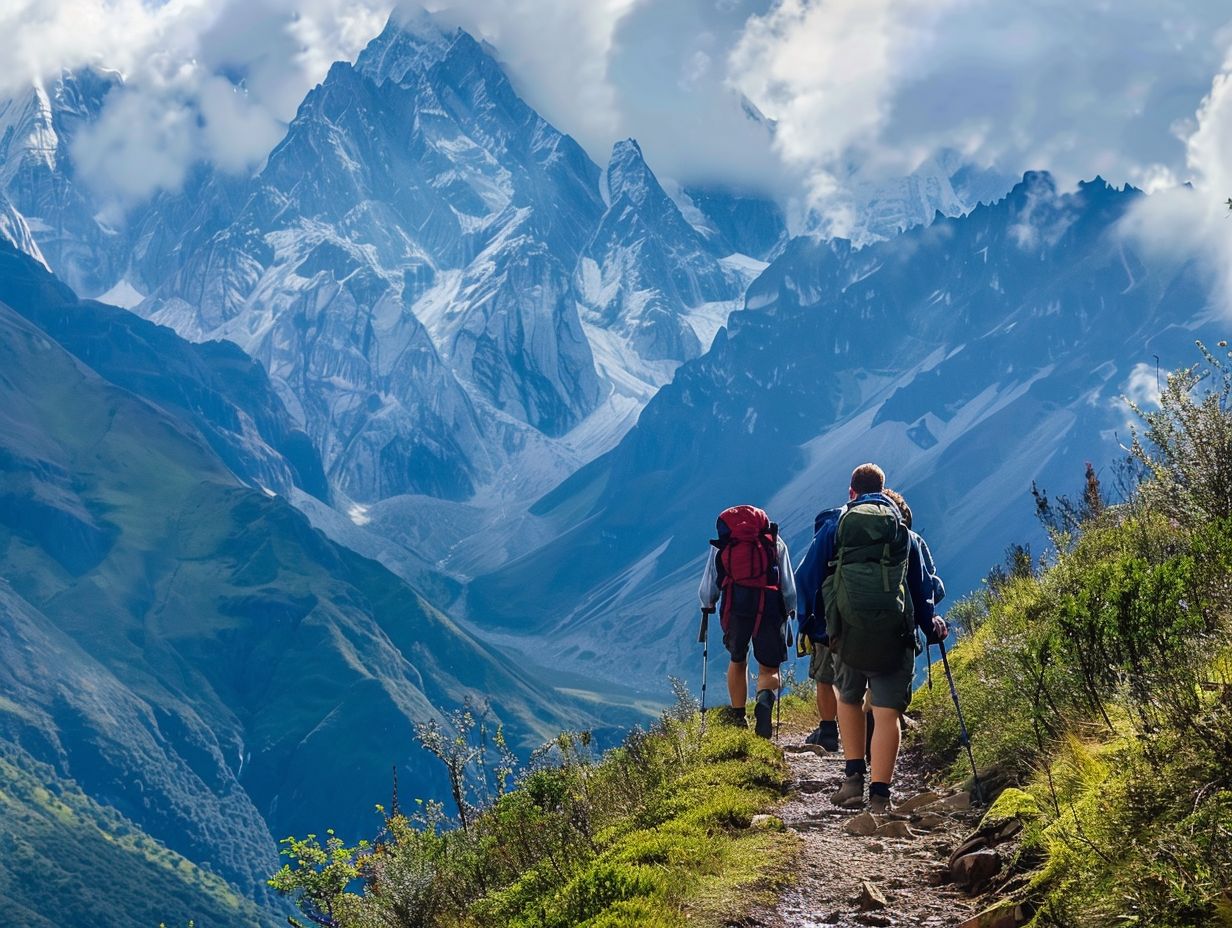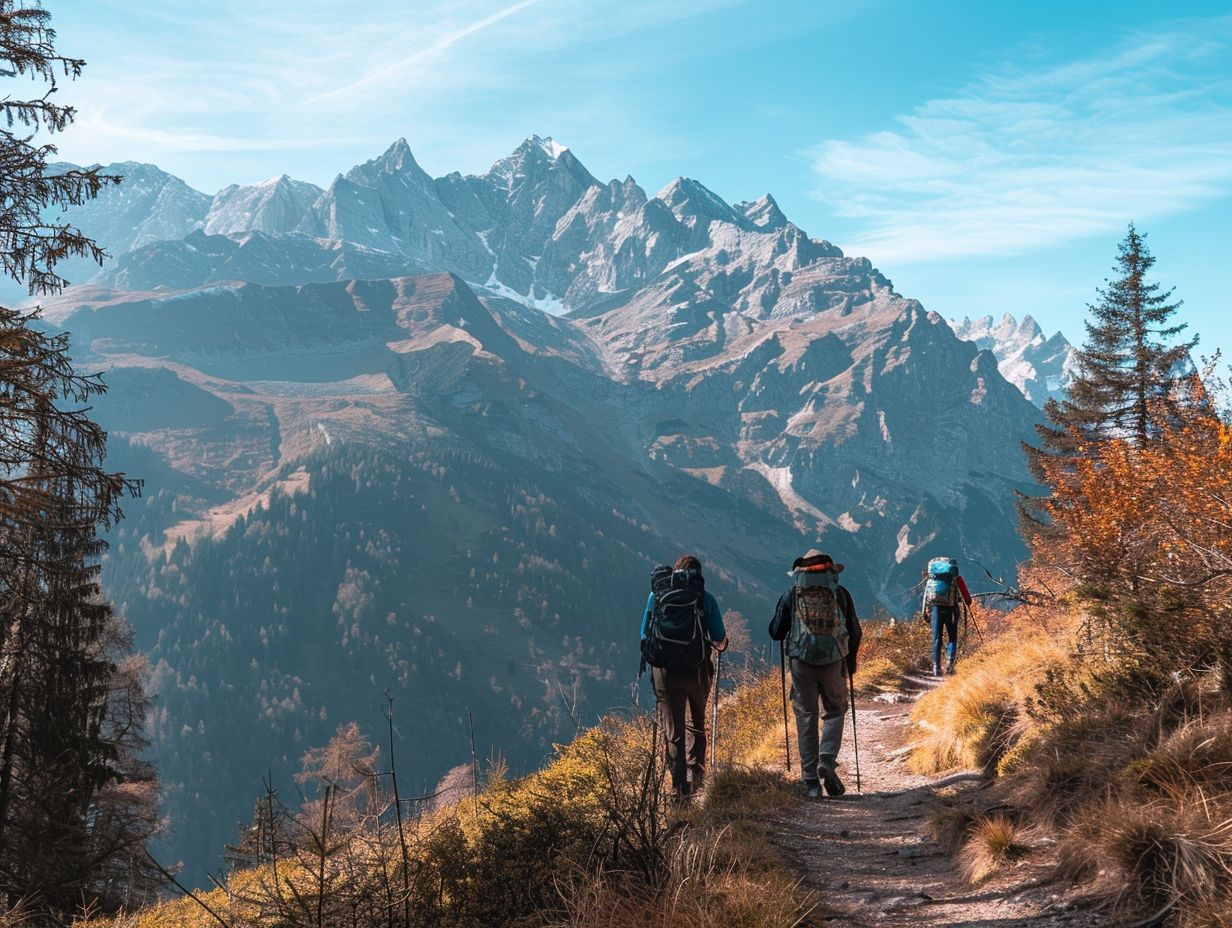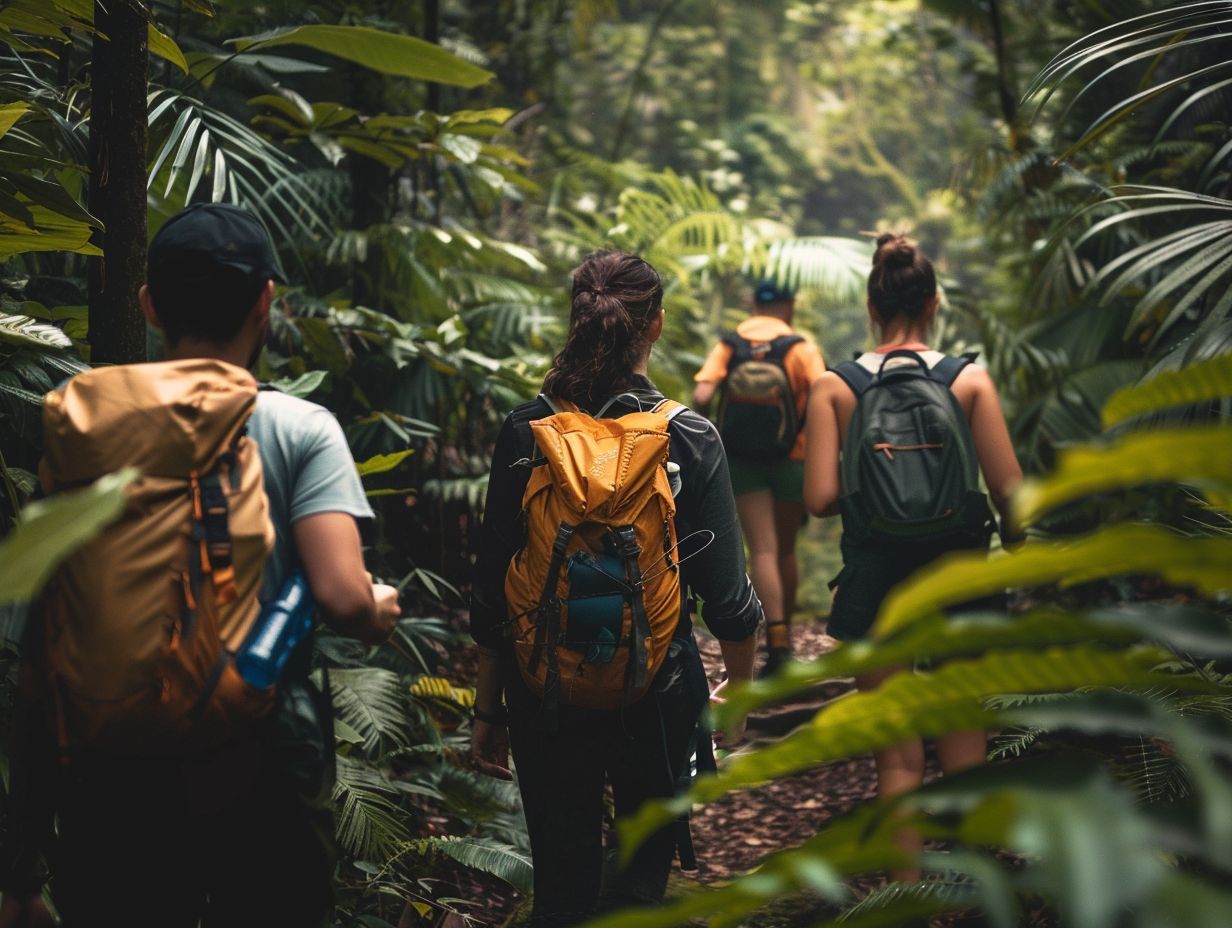

Vaibhav
- Categories: Hiking
Are you ready for an adventure of a lifetime? Planning a hiking trip abroad can be an exciting and rewarding experience, but it also requires careful preparation.
From choosing the perfect destination to packing the essential gear and considering safety concerns, there are many factors to consider before embarking on your international trek.
In this article, we will guide you through the steps to plan a successful hiking trip abroad, ensuring you have a safe and enjoyable experience from start to finish.
Key Takeaways:

- Choose your destination carefully considering factors like climate, difficulty level, and popularity. Research popular hiking destinations to get ideas.
- Thoroughly research the trail and terrain of your chosen destination and prepare accordingly. Plan your route and timeline, considering factors like distance and elevation gain.
- Gather necessary gear and supplies, pack efficiently, and consider safety and health concerns while hiking abroad. Be culturally sensitive and have a plan for emergencies and contingencies.
Step 1: Choose Your Destination
Choosing the destination acts as the initial and pivotal stage in planning for an international hiking expedition. This choice will determine the nature of the path, terrain, and overall experience to be encountered in a foreign territory.
Factors to Consider When Choosing a Hiking Destination
When preparing for a hiking expedition, it is imperative to consider various factors to guarantee a secure and gratifying venture. These factors encompass access to pertinent information and maps as well as specialised guides and recommendations tailored to the area.
An essential aspect to contemplate is the climatic conditions of the hiking destination, as they can significantly influence the overall expedition.
Harsh weather conditions can amplify the challenge and potential hazards of the journey. Therefore, it is crucial to review the weather forecast in advance and equip oneself with suitable gear, such as waterproof attire, sturdy footwear, and additional layers.
The complexity of the trail should be evaluated based on individual physical fitness levels and experience. Certain pathways may necessitate particular skills or endurance, underscoring the significance of selecting a route commensurate with one’s capabilities.
The presence of resources such as online forums, regional guidebooks, or ranger stations can furnish valuable insights and suggestions for the hike, facilitating preparation and navigation throughout the excursion.
Popular Hiking Destinations Around the World
Some of the most renowned hiking destinations worldwide are situated in the mountainous regions of Europe. Examples of these include the Alps in Switzerland, the Dolomites in Italy, and the challenging terrains of Scotland and Norway, each presenting distinctive experiences and well-equipped accommodations.
When exploring the Alps in Switzerland, hikers are treated to stunning panoramas of snow-capped peaks, idyllic alpine meadows, and pristine lakes. Meanwhile, the Dolomites in Italy feature jagged limestone peaks that emit a pink hue during sunset, creating a surreal and enchanting ambiance.
In Scotland, the rugged terrains showcase a raw beauty characterized by expansive moors, mist-enveloped mountains, and ancient castles nestled along the trails. Lastly, Norway’s remarkable fjords and towering cliffs inspire a profound sense of wonder and admiration, establishing it as an essential destination for hikers in search of an authentic wilderness adventure.
Step 2: Research the Trail and Terrain
Thorough research of the trail and terrain is imperative to guarantee safety and enhance the overall hiking experience. Various trails demand distinct levels of physical fitness and preparation, and possessing precise maps is essential for effective navigation.
What to Look for When Researching a Hiking Trail?
When conducting research on a hiking trail, it is imperative to gather thorough information from reputable guides and tips, in addition to accurate maps, in order to ensure adequate preparation for the upcoming journey.
Guides and tips serve as invaluable resources, providing valuable insights on the terrain, level of difficulty, presence of wildlife, and any potential hazards along the trail.
Various sources such as websites, forums, and social media platforms offer a plethora of user-generated content, reviews, and up-to-date trail information. Seeking advice from local park rangers or seasoned hikers can provide firsthand knowledge and valuable recommendations.
Maps play a pivotal role in strategizing your hike, helping with route navigation, identification of key landmarks, water sources, and emergency exit points. By synthesising information from diverse sources, one can develop a comprehensive itinerary and embark on a secure and gratifying hiking expedition.
How to Prepare for Different Types of Terrain?
Preparation for traversing diverse terrains necessitates not only physical fitness and endurance but also adequate readiness, skills, and appropriate equipment to address a range of challenges.
In mountainous regions, emphasis on endurance and strength training is imperative to confront the steep gradients and rugged surfaces effectively. The presence of durable hiking boots with substantial ankle support is vital for stability in such conditions.
Additionally, possessing proficiency in navigation through the utilisation of maps and compasses can serve as a preventive measure against disorientation in the rugged landscape.
Conversely, in forested areas, the significance of agility and prompt reflexes cannot be overstated for navigating through dense vegetative cover. Engaging in agility drills and enhancing reaction time are beneficial strategies for negotiating such environments effectively. Furthermore, the utility of a multitool for the clearance of obstacles along forest trails cannot be underestimated.
Step 3: Plan Your Route and Timeline

The process of meticulously planning the route and timeline is a crucial step in guaranteeing a seamless and well-coordinated hiking excursion. This involves deliberate contemplation of the trail maps, adherence to safety protocols, and effective time management strategies in order to optimise one’s overall experience.
How to Create a Hiking Itinerary
The development of a comprehensive hiking itinerary necessitates meticulous planning and the utilisation of travel guides and maps to delineate daily routes, rest areas, and potential challenges that may be encountered.
Commence this process by conducting research on the various trails accessible within the hiking locale under consideration. Factors such as difficulty level, distance, and terrain should be taken into account to select routes that are commensurate with one’s experience and physical fitness.
Subsequently, utilise maps to chart out each day’s trek, clearly demarcating significant locations such as water sources, scenic viewpoints, and camping grounds. It is imperative to refer to local guidebooks or online resources for the most current trail conditions and regulations.
Additionally, compile a comprehensive inventory of essential gear and supplies, encompassing provisions, water, navigational instruments, and emergency supplies, to ensure readiness for any eventuality.
Factors to Consider When Planning Your Timeline
When designing your itinerary, it is essential to take into account various factors, including personal stamina and fitness levels, as well as safety considerations, to prevent overexertion and ensure a safe and enjoyable hiking experience.
The level of terrain difficulty significantly influences the duration of your hike. Steep ascents, rugged trails, or adverse weather conditions can all affect your progress along the route. Considering these variables is crucial to anticipate potential delays and adjust your timeline accordingly.
Integrating breaks into your schedule for rest and nourishment is vital for sustaining energy levels and avoiding fatigue. By carefully balancing physical capabilities, trail conditions, and adequate rest periods, you can establish a realistic itinerary that enhances both enjoyment and safety throughout your hiking expedition.
Step 4: Gather Necessary Gear and Supplies
Acquiring the essential equipment and supplies is a crucial component of readiness for any hiking expedition, ensuring the inclusion of appropriate footwear, water, and other necessary items to facilitate a secure and pleasant journey.
Essential Gear for International Hiking Trips
When embarking on international hiking expeditions, the proper equipment is paramount. This includes sturdy hiking boots, a reliable rucksack, and sufficient water supplies to ensure a safe and comfortable journey.
Quality hiking boots are crucial for providing stability and ankle support on rough terrains, thus reducing the risk of injuries and ensuring an enjoyable trekking experience. Similarly, a tough rucksack equipped with adjustable straps plays a vital role in evenly distributing weight, thereby lessening strain on the shoulders and back during long hikes.
Adequate water provision, whether through a hydration system or water containers, is essential for maintaining hydration levels in isolated areas, especially in demanding climates where access to fresh water may be limited.
Investing in high-quality equipment not only enhances the overall hiking experience but also protects one’s safety and well-being during international trips.
How to Pack Efficiently for a Hiking Trip Abroad
Efficiently preparing for an overseas hiking expedition necessitates adhering to practical advice and guidelines to ensure the inclusion of only essential items in one’s rucksack, all while maintaining a lightweight and manageable load.
A fundamental approach involves crafting a comprehensive packing inventory that encompasses essential items such as appropriate clothing layers, durable footwear, first aid provisions, and ample hydration supplies. Emphasis is placed on selecting versatile articles that serve multiple functions, thereby reducing bulk and weight in the rucksack.
Additionally, it proves beneficial to procure lightweight and compact equipment, such as a tent, sleeping bag, and cooking provisions. Engaging with instructional materials or online references assists in determining the requisite gear according to the environmental conditions, topography, and duration of the international trek.
Step 5: Consider Safety and Health Concerns
When organising a hiking excursion, particularly overseas, it is crucial to prioritise safety and health considerations. This entails understanding medical requirements, acquiring suitable insurance coverage, and remaining informed about health advisories, such as those issued by the CDC, which includes guidelines related to COVID-19.
Common Safety Risks While Hiking Abroad

The act of hiking in foreign countries poses numerous common safety hazards, which include unfamiliar terrain, potential language barriers, and unforeseen challenges necessitating thorough preparation and access to precise information.
One of the primary safety concerns when hiking internationally pertains to navigating through diverse terrains, which may significantly differ from one’s accustomed surroundings. It is imperative to conduct comprehensive research on the specific trail conditions, elevation levels, and weather patterns of the intended destination beforehand.
Language barriers may present obstacles in seeking assistance or communicating with local inhabitants in emergency situations. Carrying a translation application or a language guide can prove immensely advantageous in such circumstances. Being cognisant of probable hazards and possessing the requisite resources can greatly diminish risks and augment the overall hiking experience.
How to Stay Healthy and Safe on Your Trip
Ensuring one’s health and safety during a hiking trip entails adherence to practical guidelines, including the carrying of essential medical supplies, possessing valid insurance coverage, and adherence to health standards to mitigate any potential risks.
Furthermore, it is imperative to communicate your hiking itinerary and anticipated return time to a trusted individual. Ahead of commencing the excursion, it is essential to ascertain that one’s physical fitness levels are commensurate with the planned trek.
Maintaining adequate hydration levels by carrying a sufficient supply of water and snacks to sustain energy levels during the hike is recommended. Familiarising oneself with the hiking location and preparing for potential weather fluctuations is advisable.
Additionally, it is prudent to have a fully charged mobile phone and a basic first aid kit on hand to address minor injuries that may arise during the hike.
Step 6: Learn About the Local Culture and Customs
Acquiring knowledge of the local culture and customs is an essential aspect of hiking overseas. A comprehensive understanding of the language, traditions, and social norms can significantly enrich your experience and facilitate considerate interactions with local residents.
Why It’s Important to Be Culturally Sensitive While Hiking Abroad
Demonstrating cultural sensitivity while hiking abroad holds significant importance as it exemplifies respect for the local culture and traditions, contributing to positive interactions and experiences within the community.
Cultural sensitivity plays a pivotal role in fostering mutual understanding, minimising misunderstandings, and cultivating a sense of unity among diverse groups. Ahead of embarking on an exploration of a new destination, thorough research into local customs, taboos, and communication norms is paramount in order to prevent inadvertent offences.
Simple gestures such as acquainting oneself with a few local phrases or greeting locals in their native language can play a crucial role in establishing rapport. Being cognisant of appropriate attire, conduct, and gestures within different cultural contexts can enrich one’s travel experience and leave a favourable impression.
Embracing cultural sensitivity not only enhances personal journeys but also contributes to the cultivation of a more harmonious global community.
Tips for Interacting with Locals and Respecting the Environment
When engaging with locals and being conscious of the environment, it is crucial to adhere to practical guidelines. This can include familiarising oneself with basic phrases in the local language and being cognisant of the impact one has on the natural surroundings.
Interacting with the community in a respectful and courteous manner can significantly enrich one’s travel experience. It is advisable to observe and respect local customs and traditions, displaying genuine interest in the local way of life. By demonstrating a willingness to comprehend and adjust, individuals can cultivate positive relationships and establish meaningful connections.
Engaging in environmentally-friendly activities such as recycling and resource conservation serves the dual purpose of preserving the environment and showcasing a commitment to sustainable travel practices.
It is imperative to proactively ensure that the places visited are left in a cleaner state than when encountered, thereby leaving a positive imprint on both the community and the ecosystem.
Step 7: Plan for Emergencies and Contingencies
Preparing for emergencies and contingencies is a crucial aspect of hiking preparedness, encompassing a comprehensive understanding of potential obstacles, safety procedures, and survival strategies to adeptly handle unforeseen circumstances.
How to Handle Unexpected Situations While Hiking Abroad?
Navigating unexpected scenarios while hiking abroad necessitates a robust safety strategy and comprehensive guide that encompasses familiarity with local emergency contacts, possession of a well-equipped first aid kit, and vigilance of one’s surroundings.
In case of injuries, it is imperative to first assess the severity of the situation and administer prompt first aid to the afflicted individual. A thorough knowledge of the nearby medical facilities or emergency services in the vicinity is crucial.
Should one become disoriented during the hike, it is advised to maintain composure, remain stationary if deemed safe, and signal for assistance through the utilisation of signalling tools or by generating loud noises.
In the presence of adverse weather conditions, seek immediate shelter and shield oneself from the elements by utilising appropriate gear and attire.
What to Do in Case of an Emergency or Natural Disaster?

In case of an emergency or natural disaster whilst hiking, adherence to safety and survival protocols is imperative. This includes promptly seeking shelter, contacting local authorities, and having a well-defined emergency plan.
It is essential to maintain composure and assess the situation methodically as initial steps. Once a secure shelter is established, ensuring accessibility and functionality of communication devices is crucial.
Additionally, it is advisable to have essential survival supplies such as first aid kits, water, and non-perishable food readily available. Familiarising oneself with specific emergency protocols of the area can significantly facilitate a prompt response.
Prompt decision-making and effective communication with fellow hikers or rescue teams are paramount for achieving a successful outcome in such situations.
Frequently Asked Questions
1. What are the first steps to planning a hiking trip abroad?
The first steps to planning a hiking trip abroad are to research your destination, determine your budget, and acquire any necessary visas or permits. You should also consider the time of year and weather conditions of your destination before finalising your plans.
2. What should I consider when choosing a hiking trail for an international trek?
When choosing a hiking trail for an international trek, it’s important to consider the difficulty level, length, and terrain of the trail. You should also research the safety of the area and any potential hazards, such as extreme weather or wildlife.
3. How much should I budget for a hiking trip abroad?
The budget for a hiking trip abroad will vary depending on your destination, length of stay, and the level of luxury you desire. A good rule of thumb is to budget for transportation, accommodations, meals, and any necessary gear or permits. It’s also a good idea to include some extra funds for unexpected expenses.
4. Do I need any special gear for an international hiking trip?
Yes, you may need some special gear for an international hiking trip, especially if you are planning on camping or trekking through rugged terrain. It’s important to research the necessary gear for your destination and invest in quality equipment that will withstand the challenges of your trip.
5. What should I do to prepare physically for an international hiking trip?
In order to prepare physically for an international hiking trip, it’s important to start training well in advance. This can include regular cardiovascular exercise, strength training, and practicing hiking on local trails with a fully loaded pack. It’s also important to consult with a doctor to ensure you are physically fit for the trip.
6. What are some important safety precautions to take while hiking abroad?
Some important safety precautions to take while hiking abroad include staying on marked trails, keeping a map and compass with you at all times, and carrying a first aid kit. It’s also important to inform someone of your itinerary and check in with them regularly. Additionally, be aware of your surroundings and follow any local safety guidelines or regulations.
Share:
By submitting your email address, you are agreeing to receive marketing emails from theexpertcamper.co.uk.
We’ll never share your email address and you can unsubscribe at any time. Privacy policy
Related Posts

A Seasonal Guide To Hiking In The Peak District
Are you ready to lace up your hiking boots and explore the stunning landscapes of the Peak District? This seasonal guide will take you through

Hiking Challenges Preparing For Your First Ultrahike
Are you ready to take your hiking adventures to the next level? Ultra-hiking offers a unique combination of physical and mental challenges, breathtaking scenery, and

Ecofriendly Hiking Tips For Sustainable Adventures
Are you an outdoor enthusiast looking to minimise your impact on the environment while enjoying the great outdoors? Eco-friendly hiking is the perfect solution! We

The Best Hiking Trails For Experiencing UK Wildlife
When exploring the picturesque hiking trails of the UK, you can expect to encounter a diverse array of wildlife. From majestic birds soaring overhead to

Wildflower Walks The Best Trails For Nature Lovers
Are you a nature lover looking to embark on a wildflower walk? Explore the best trails for wildflower walks, including [Trail Name 1], [Trail Name
























